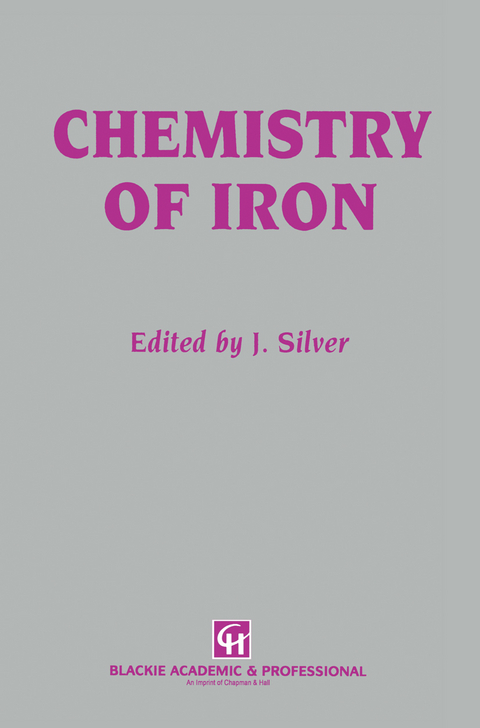
Chemistry of Iron
Chapman and Hall (Verlag)
978-0-7514-0062-5 (ISBN)
1 Introduction to iron chemistry.- 1.1 Introduction.- 1.2 Importance of iron.- 1.3 Iron minerals and ores.- 1.4 Pure iron and its main chemical and physical properties.- 1.5 Isotopes of iron.- 1.6 Ionisation energies.- 1.7 Oxidation states.- 1.8 Spin states.- 1.9 Magnetics.- 1.10 Electronic structure.- 1.11 Organometallic chemistry of iron.- 1.12 The biochemical importance of iron.- 1.13 The future of iron chemistry and biological chemistry.- References.- 2 Industrial chemistry of iron and its compounds.- 2.1 History.- 2.2 Production of iron.- 2.3 Chemistry in the blast furnace.- 2.4 Commercial iron.- 2.5 Pickling of steel.- 2.6 Main uses of steel.- 2.7 Corrosion of iron and steel.- 2.8 Prevention of corrosion.- 2.9 Use of iron compounds.- References.- 3 Inorganic chemistry of iron.- 3.1 Introduction.- 3.2 Lattice structures.- 3.3 High pressure effects.- 3.4 Spin equilibria.- References.- 4 Organo-iron compounds.- 4.1 Introduction.- 4.2 Iron carbonyls.- 4.3 Cyclopentadienyl iron complexes.- 4.4 Other hydrocarbon complexes.- 4.5 Miscellaneous complexes.- 4.6 Practical applications of organo-iron compounds.- Further reading.- References.- 5 Spectroscopic methods for the study of iron chemistry.- 5.1 Introduction.- 5.2 Hyperfine interactions.- 5.3 Interpretation of57Fe Mössbauer spectra.- References.- 6 Biological iron.- 6.1 Control of intracellular levels of iron.- 6.2 Iron-sulphur proteins.- 6.3 Haem proteins.- 6.4 Non-haem and non-Fe/S proteins.- References.- 7 Models for iron biomolecules.- 7.1 Models for iron biomolecules.- 7.2 Haem proteins.- 7.3 Models for iron—sulphur proteins.- 7.4 Proteins containing monomeric iron sites.- 7.5 Oxo-bridged di-iron centres.- 7.6 Models for the uptake and transport of iron.- 7.7 Models for biomineralisation processes.-References.- 8 Iron chelators of clinical significance.- 8.1 Iron transport and distribution.- 8.2 Systemic iron overload.- 8.3 Localised and temporary elevation of iron levels.- 8.4 Protection against cellular damage induced by redox cycling chemicals.- 8.5 Selective inhibition of non-haem containing enzymes.- 8.6 Treatment of anaemia with iron complexes.- References.
All you wanted to know about the chemistry of iron is provided by eight contributed chapters....greatly welcomed for its contribution to the organometallic field. - Organometallic Compounds; Chapters on inorganic iron compounds and spectroscopic methods useful for iron complete the book which has a modest but useful index - Organometallic Compounds; Everything from the industrial history of iron and its inorganic chemistry to the biogical role of the metal is covered in enough detail to keep the straight chemistry undergraduate intrigued and to add chemical interest to a background reading list for geologists, metallurgists and biologists alike. - New Scientist; This [book] has been waiting to be written for years ... tremendously useful to a wide range of readers and researchers. - Education in Chemistry; Chemistry of ironprovides a skillful survey...a spread of topics conveying a true impression of the chemistry, and short articles of wide disparity...the book succeeds ingiving a clear and scholarly overview of its field. - Chemistry & Industry - London; This book is a timely collection of articles covering aspects of iron...and methods of metal protection. It is effectively written and provides just the right amount of information for undergraduates...the book should find a place on library shelves and will be a significant source of reference. - Chemistry in Britain
| Zusatzinfo | XI, 306 p. |
|---|---|
| Verlagsort | London |
| Sprache | englisch |
| Maße | 155 x 235 mm |
| Themenwelt | Naturwissenschaften ► Chemie ► Anorganische Chemie |
| ISBN-10 | 0-7514-0062-9 / 0751400629 |
| ISBN-13 | 978-0-7514-0062-5 / 9780751400625 |
| Zustand | Neuware |
| Haben Sie eine Frage zum Produkt? |
aus dem Bereich


